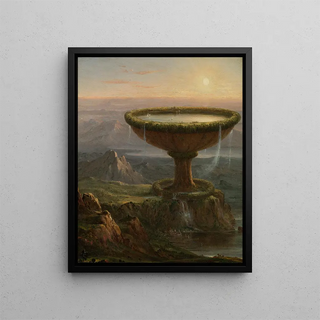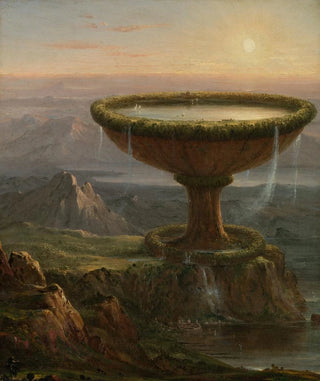Art print | La Coupe des Titans - Thomas Cole


View from behind

Frame (optional)
The Titan Cup, an iconic art print by Thomas Cole, stands as a monument to the grandeur of nature and the power of human imagination. Painted in the heart of the 19th century, this canvas is not merely a visual representation but a true pictorial poem that evokes epic struggles between gods and titans, while reflecting the concerns of its time. In a context where industrialization was beginning to transform the American landscape, Cole invites the viewer to contemplate the majesty of natural forces, while questioning man's place in the vastness of the universe. This work, both grandiose and introspective, embodies the romantic spirit that runs through the art of its era.
Style and uniqueness of the work
Thomas Cole's style is distinguished by his bold use of color and light, creating atmospheres that are both dramatic and serene. In The Titan Cup, vibrant hues and striking contrasts bring to life a scene where nature and myth meet. The majestic mountains rise in the background, symbolizing strength and permanence, while mythological figures, full of movement, seem to dance across the canvas. Cole succeeds in capturing a moment of tension, where the sublime of nature contrasts with the fragility of human existence. Every detail, from swirling clouds to flashes of light, contributes to a harmonious composition that transports the viewer to a world that is both familiar and strangely distant.
The artist and his influence
Thomas Cole, considered the founder of the Hudson River School, played a fundamental role in the evolution of American landscape art. His commitment to nature and his desire to depict it with emotional depth paved the way for many artists. Through his works, he was able to capture the essence of the American landscape, while incorporating narrative elements drawn from mythology and history. Cole was also a pioneer in exploring themes of conservation and environmental responsibility, concerns that still resonate today. The Titan Cup, in particular, bears witness to his

Matte finish

View from behind

Frame (optional)
The Titan Cup, an iconic art print by Thomas Cole, stands as a monument to the grandeur of nature and the power of human imagination. Painted in the heart of the 19th century, this canvas is not merely a visual representation but a true pictorial poem that evokes epic struggles between gods and titans, while reflecting the concerns of its time. In a context where industrialization was beginning to transform the American landscape, Cole invites the viewer to contemplate the majesty of natural forces, while questioning man's place in the vastness of the universe. This work, both grandiose and introspective, embodies the romantic spirit that runs through the art of its era.
Style and uniqueness of the work
Thomas Cole's style is distinguished by his bold use of color and light, creating atmospheres that are both dramatic and serene. In The Titan Cup, vibrant hues and striking contrasts bring to life a scene where nature and myth meet. The majestic mountains rise in the background, symbolizing strength and permanence, while mythological figures, full of movement, seem to dance across the canvas. Cole succeeds in capturing a moment of tension, where the sublime of nature contrasts with the fragility of human existence. Every detail, from swirling clouds to flashes of light, contributes to a harmonious composition that transports the viewer to a world that is both familiar and strangely distant.
The artist and his influence
Thomas Cole, considered the founder of the Hudson River School, played a fundamental role in the evolution of American landscape art. His commitment to nature and his desire to depict it with emotional depth paved the way for many artists. Through his works, he was able to capture the essence of the American landscape, while incorporating narrative elements drawn from mythology and history. Cole was also a pioneer in exploring themes of conservation and environmental responsibility, concerns that still resonate today. The Titan Cup, in particular, bears witness to his






